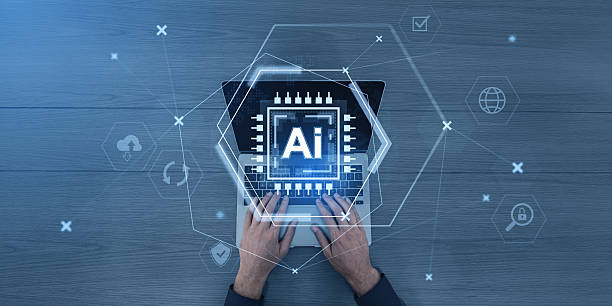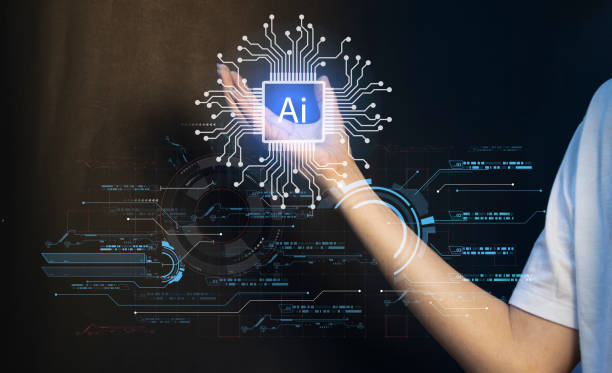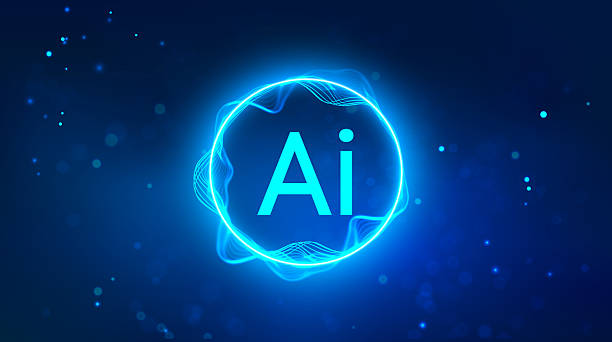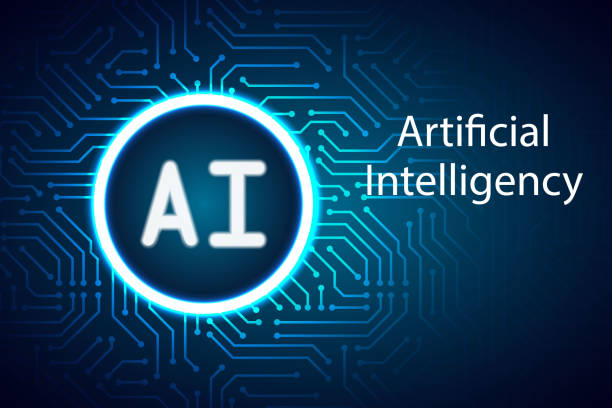What is Artificial Intelligence? A Simple Definition

#Artificial_Intelligence (AI) is a branch of computer science that deals with creating machines that can perform tasks that usually require human intelligence.
These tasks include learning, problem-solving, pattern recognition, natural language understanding, decision-making, and more.
Artificial Intelligence strives to create systems that can think and act independently.
In fact, AI is a broad field that includes various approaches and techniques.
Some of the most common techniques include machine learning, deep neural networks, and natural language processing.
Each of these techniques is optimized to solve specific types of problems.
To better understand Artificial Intelligence, it’s important to know its goal.
The ultimate goal is to create machines that can think and act like humans.
However, this is a long-term goal, and many of today’s AI systems are designed to perform specific tasks.
For example, an AI system might be trained to recognize faces in images or translate languages.
How much does losing business leads due to an unprofessional website cost you? Solve this problem forever with a professional corporate website design by Rasaweb!
✅ Increase credibility and trust of potential customers
✅ Easier attraction of new business leads
⚡ Get a free consultation now!
Brief History of Artificial Intelligence

The history of Artificial Intelligence dates back to the 1950s.
At that time, researchers began exploring the idea of whether machines could be built that could think.
Alan Turing, a British computer scientist, proposed a test called the Turing Test, which would serve as a measure of machine intelligence.
In the 1960s and 1970s, research in AI made some progress.
Programs were created that could play chess and solve mathematical problems.
However, progress was limited, and AI faced many obstacles.
In the 1980s and 1990s, AI once again gained attention.
This time, the reason was the development of new machine learning algorithms and the increasing computational power of computers.
Neural networks, which are computational models inspired by the human brain, emerged as a powerful tool for machine learning.
Today, AI is used in many fields, including self-driving cars, facial recognition, language translation, voice recognition, product recommendations, and more.
Artificial Intelligence is rapidly advancing and is expected to play an even more significant role in our lives in the future.
Types of Artificial Intelligence

Artificial Intelligence can be categorized into different types based on its capabilities and functions.
Narrow AI (Artificial Narrow Intelligence) This type of AI is designed to perform a specific task.
Most of today’s AI systems are of this type.
Examples include facial recognition systems, voice recognition, and product recommendations.
General AI (Artificial General Intelligence) This type of AI has the ability to perform any task that a human can.
This type of AI is still in the development stages and is not widely available.
Super AI (Artificial Super Intelligence) This type of AI surpasses human intelligence.
This type of AI is still hypothetical, and currently, there are no examples of it.
In addition to these categories, AI can also be categorized based on how it learns:
Machine Learning This method allows machines to learn from data without explicit programming.
Deep Learning This method uses deep neural networks to learn patterns in data.
This is a subset of machine learning that has become very popular in recent years.
Understanding the different types of AI helps you comprehend the capabilities of each of these technologies and the areas in which they can be used.
| Type of AI | Description |
|---|---|
| Narrow AI | Designed to perform a specific task. |
| General AI | Has the ability to perform any task that a human can. |
| Super AI | Exceeds human intelligence. |
Applications of Artificial Intelligence

Artificial Intelligence has a very wide range of applications.
Below are some of the most common applications:
Self-driving cars AI enables cars to navigate roads without the need for a human driver.
AI systems use sensors, cameras, and map data to understand their surroundings and make decisions.
Facial Recognition AI can recognize faces in images and videos.
This technology is used in security systems, social media, and marketing.
Natural Language Processing (NLP) AI enables machines to understand and process human language.
This technology is used in chatbots, language translation, sentiment analysis, and more.
Product Recommendations AI can suggest products to users based on their purchase history and behavior.
This technology is used in online stores and video streaming platforms.
Medicine AI is used in diagnosing diseases, developing drugs, and providing medical care.
For example, AI systems can analyze medical images and identify signs of illness.
Finance AI is used in fraud detection, risk management, and providing personalized financial services.
These are just a few examples of the applications of Artificial Intelligence.
As this technology advances, its applications are expected to become even broader in the future.
Are you tired of your company website not meeting your expectations? With Rasaweb, design a professional website that truly represents your business!
✅ Increase attraction of new customers and sales leads
✅ Boost your brand’s credibility and trust with your audience
⚡ Get a free website design consultation!
Machine Learning and Its Role in Artificial Intelligence

Machine learning is one of the most important branches of Artificial Intelligence.
In machine learning, machines learn from data without explicit programming.
This means that machines can identify patterns and make decisions by analyzing data.
Machine Learning Algorithms There are various algorithms for machine learning.
Some of the most common algorithms include:
Regression Used to predict a continuous value.
Classification Used to categorize data into different classes.
Clustering Used to group similar data together.
Reinforcement Learning Used to train machines to perform a specific task by receiving rewards or penalties.
Machine Learning Process The machine learning process typically includes the following steps:
Data Collection Gathering data relevant to the problem at hand.
Data Preprocessing Cleaning and preparing data for use in the machine learning algorithm.
Algorithm Selection Choosing the appropriate machine learning algorithm for the problem.
Model Training Training the algorithm using the collected data.
Model Evaluation Assessing the model’s performance using test data.
Model Deployment Using the trained model for prediction or decision-making.
Machine learning plays a very important role in the advancement of Artificial Intelligence.
By using machine learning, machines can perform tasks that were previously impossible.
Deep Neural Networks

Deep Neural Networks are a type of artificial neural network composed of multiple layers.
These layers enable machines to learn more complex patterns in data.
Structure of Deep Neural Networks Deep neural networks are composed of artificial neurons arranged in different layers.
Each neuron receives an input, processes it, and produces an output.
The output of one neuron can be used as input for other neurons in subsequent layers.
Learning Process in Deep Neural Networks The learning process in deep neural networks involves adjusting the weights between neurons.
Weights determine how much each neuron influences the output of other neurons.
During the learning process, weights are adjusted so that the network can correctly identify patterns in the data.
Applications of Deep Neural Networks Deep neural networks have applications in many fields, including:
Image Recognition Identifying objects, faces, and other patterns in images.
Speech Recognition Converting speech to text and recognizing sounds.
Natural Language Processing Language translation, sentiment analysis, and text generation.
Gaming Playing complex games such as chess and Go.
Deep neural networks are one of the most powerful tools in Artificial Intelligence.
Using these networks, machines can perform tasks that were previously impossible.
Challenges and Limitations of Artificial Intelligence

Despite significant advances in Artificial Intelligence, this technology still faces challenges and limitations.
Below are some of these challenges and limitations:
Need for Large Amounts of Data AI systems, especially deep neural networks, require vast amounts of data for learning.
Collecting and processing this data can be time-consuming and costly.
Interpretability Many AI systems, particularly deep neural networks, act as black boxes.
This means that understanding how these systems make decisions is difficult.
This issue can be problematic in fields such as medicine and law.
Bias AI systems can learn biases from their training data.
These biases can lead to unfair and discriminatory decisions.
Security AI systems can be attacked and misused.
For example, attackers can manipulate training data to make the AI system make incorrect decisions.
Cost Developing and deploying AI systems can be expensive.
This cost includes data collection, model training, and system maintenance.
Despite these challenges and limitations, Artificial Intelligence remains a very promising technology.
By striving to overcome these challenges, we can leverage the full potential of this technology.
| Challenge | Description |
|---|---|
| Need for large amounts of data | AI systems require very large amounts of data for learning. |
| Interpretability | Understanding how AI systems make decisions is difficult. |
| Bias | AI systems can learn biases from their training data. |
| Security | AI systems can be attacked and exploited. |
| Cost | Developing and deploying AI systems can be costly. |
The Future of Artificial Intelligence

The future of Artificial Intelligence looks very bright.
As this technology advances, its role in our lives is expected to become more prominent.
Below are some of the key trends in the future of AI:
Explainable AI Efforts to create AI systems that can explain how they make decisions.
Ethical AI Efforts to ensure that AI systems operate fairly and ethically.
Autonomous AI Efforts to create AI systems that can operate and make decisions independently.
Quantum AI Using quantum computers to train more complex AI models.
Ubiquitous AI Integrating AI into all aspects of our lives, including homes, workplaces, and cities.
With the development of this technology, Artificial Intelligence can help solve some of the world’s biggest challenges, including climate change, diseases, and poverty.
Artificial Intelligence has the potential to create a better future for everyone.
Are you disappointed with your online store’s low conversion rate? Rasaweb transforms your online store into a powerful tool for attracting and converting customers!
✅ Significantly increase the conversion rate of visitors to buyers
✅ Unparalleled user experience to boost customer satisfaction and loyalty⚡ Get a free consultation from Rasaweb!
Artificial Intelligence and Its Impact on Jobs

Artificial Intelligence will have a significant impact on the job market.
Some jobs will be completely replaced by machines, while other jobs will change and require new skills.
Below are some of the key impacts of AI on jobs:
Automation Artificial Intelligence can automate many repetitive and routine tasks.
This can lead to a reduced need for human labor in some industries.
Creation of New Jobs AI can also create new jobs.
For example, demand for AI specialists, data scientists, and machine learning engineers is increasing.
Changing Skill Requirements Many jobs will require new skills to work with AI.
These skills include analytical skills, problem-solving skills, and communication skills.
Retraining To adapt to changes in the job market, many people will need retraining.
Governments and organizations must provide training programs to help individuals learn new skills.
The impact of Artificial Intelligence on jobs is a complex issue.
With planning and preparation, we can benefit from this technology and prevent its negative effects.
How to Learn Artificial Intelligence?

If you are interested in learning Artificial Intelligence, there are many resources to get started.
Below are some of these resources:
Online Courses Online learning platforms such as Coursera, edX, and Udacity offer various courses in Artificial Intelligence.
Books Many books are available on Artificial Intelligence that you can use to learn basic and advanced concepts.
Articles Scientific articles can help you stay informed about the latest advancements in Artificial Intelligence.
Hands-on Projects Working on practical projects helps you apply theoretical concepts in practice.
Online Communities Online communities such as Stack Overflow and Reddit are good places to ask questions and share your knowledge with others.
Learning Artificial Intelligence requires effort and perseverance.
By using the right resources and continuous practice, you can gain proficiency in this field.
Remember that Artificial Intelligence is a very broad field, and there is no single way to learn it.
The best way to learn Artificial Intelligence is to find a method that suits you best and motivates you to continue learning.
Also, by using AI technology, you can boost your business.
Frequently Asked Questions
| Question | Answer |
|---|---|
| What is the definition of Artificial Intelligence (AI)? | It is a field in computer science that aims to create intelligent machines capable of thinking, learning, problem-solving, and decision-making like humans. |
| Mention some common applications of Artificial Intelligence. | Includes self-driving cars, voice assistants (like Siri and Alexa), recommendation systems (like Netflix and Amazon), facial recognition, and medical diagnosis. |
| What is the difference between Narrow AI (ANI) and General AI (AGI)? | Narrow AI is specialized in one specific task, while General AI possesses human-level intellectual ability to perform any cognitive task. |
| What is Machine Learning and its relationship to Artificial Intelligence? | Machine Learning is a branch of Artificial Intelligence that focuses on developing algorithms that allow systems to learn from data without explicit programming. |
| What are Artificial Neural Networks? | They are computational models inspired by the structure and function of the human brain, used in deep learning to process data and discover complex patterns. |
| Mention some ethical challenges related to Artificial Intelligence. | These include privacy issues, bias in data and algorithms, job displacement, and accountability in case of errors or unfair decisions. |
| What is Natural Language Processing (NLP)? | It is a branch of Artificial Intelligence that focuses on enabling computers to understand, interpret, and generate human language in a useful and interactive way. |
| How can Artificial Intelligence affect the job market? | It can lead to the automation of some routine tasks, which requires retraining workers and creating new jobs in areas of designing, developing, and maintaining AI systems. |
| What is Computer Vision? | It is a field in Artificial Intelligence that enables computers to “see”, understand, and interpret images and video clips in the same way humans do, allowing them to recognize objects and faces. |
| What is the importance of data in developing Artificial Intelligence systems? | Data is the fuel that powers AI systems, especially in machine learning. The quality and quantity of data significantly affect the accuracy and performance of models and their ability to learn and make correct decisions. |
And other services of Rasa Web Advertising Agency in the field of advertising
Smart Customer Journey Map: A combination of creativity and technology for digital branding through optimizing key pages.
Smart Data Analysis: A combination of creativity and technology for customer acquisition through custom programming.
Smart Marketplace: A professional solution for increasing website traffic with a focus on attractive UI design.
Smart Social Media: An effective tool for user engagement with the help of Google Ads management.
Smart Marketing Automation: A fast and efficient solution for customer behavior analysis with a focus on Google Ads management.
And over hundreds of other services in the field of internet advertising, advertising consultation, and organizational solutions
Internet Advertising | Advertising Strategy | Advertorials
Resources
What is Artificial Intelligence? A Complete Guide for Beginners
AI Learning Roadmap
Applications of Artificial Intelligence in Various Industries
Artificial Intelligence in Daily Life: Understanding Concepts and Applications
💡 For your business, a brighter future awaits with Rasaweb’s professional services. From SEO-optimized website design to digital marketing strategies, we are with you every step of the way to ensure a powerful online presence.
📍 Tehran, Mirdamad Street, next to Bank Markazi, Southern Kazerun Alley, Ramin Alley, No. 6




